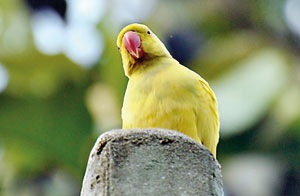“This yellow, Rose-ringed Parakeet is coming to the bird feeder in our garden with other birds. What is this bird?” asked Dr. D. Rodrigo, a puzzled birder circulating a series of photos to the Field Ornithology Group’s (FOGSL) email group on May 2. The photos showed a beautiful bird very similar to a normal Rose-ringed Parakeet or Mala Girawa, but unlike the other Rose-ringed Parakeets which are green, this one was yellow.
 |
| The proud yellow parakeet with tilted head |
Dr. Rodrigo lives in Attidiya and maintains a food table which is visited by a flock of Rose-ringed Parakeets.
“This Yellow Parakeet was first spotted about three months ago,” Dr. Rodrigo commented. Though different in colour, the bird blended in with the other parakeets, resting, preening and sharing food from the same table. Dr. Rodrigo said that the bird was quite normal in its behaviour and others in the flock too treated it as a family member.
Being an ardent birdwatcher, Dr. Rodrigo recognized it could be a Rose-ringed Parakeet. But was this an Albino or an uncommon mutation, he wanted to know.
"Yellow parakeets are known as “lutinos” and such birds are occasionally seen. Partial lutinos are encountered more often. The colour variation is probably caused by a genetic mutation, something like the black leopard,” Rex I. De Silva, an expert birder and part of the egroup replied solving the mystery. Like the case of an albino, a lutino is a mutation where the mutated gene functions to stop or slow down the production of melanin which defines the skin or the colours of the feathers.
Leucism is a condition characterized by reduced pigmentations that add colour to animal cells and tissues. Leucism is said to reduce all types of skin pigment, not just melanin as in the case of albinoism. The Lutino mutation removes most of the melanin in the plumage, soft tissues, and the eyes. And when combined with green, the mutation brings up a yellow plumage.
Explaining the lutino phenomena, veteran ornithologist Prof. Sarath Kotagama said lutino birds are reported occasionally. He said there is a possibility that in a certain area, there can be more Lutinos as the birds with the mutated gene can cross-breed and their offspring are more prone to inherit the mutation.
The Rose-ringed Parakeet is among the most popular birds in Sri Lanka, a bird virtually everybody can recognize. Prof. Kotagama did his PhD. research based at Polonnaruwa on these birds. Ornithologists call the Rose-ringed Parakeet a bird that can adapt to its environmental conditions and withstand the onslaught of urbanisation and deforestation. It is believed their numbers are increasing and they can be found even in crowded cities like Colombo. Rose-ringed Parakeets’ adaptability is clearly shown in the fact that they are even naturalized in many foreign countries. London, for example, now has a feral population of Rose-ringed Parakeets - initially escaped from the pet trade.
While Lutino Parakeets are noticeable straightway, there could be other different birds or special behaviour even among very common birds that visit our gardens. Prof. Kotagama urges the bird loving public to watch the visitors to their gardens, whether common or rare.
The Endemic Lutino in Knuckles
While Dr. Rodrigo observed his lutino Parakeet leisurely from his porch, a well-known field naturalist – Mendis Wickremasinghe, while hiking through difficult terrain in the Loolecondera estate in the foothills of Knuckles recorded another lutino. This time, it was an Endemic Sri Lanka Hanging Parrot – a little bird that usually flies over canopy level.
“We were first alerted about a small yellow bird flying over canopy level from the planter of Loolecondera and were curious to observe it. After observing the terrain, one day we spotted this beautiful Yellow Hanging Parrot when it came to feed,” said Mendis, who is a reptile expert.
Mendis and the team continued to observe this bird and came to the conclusion that this was a Lutino Hanging Parrot. |


